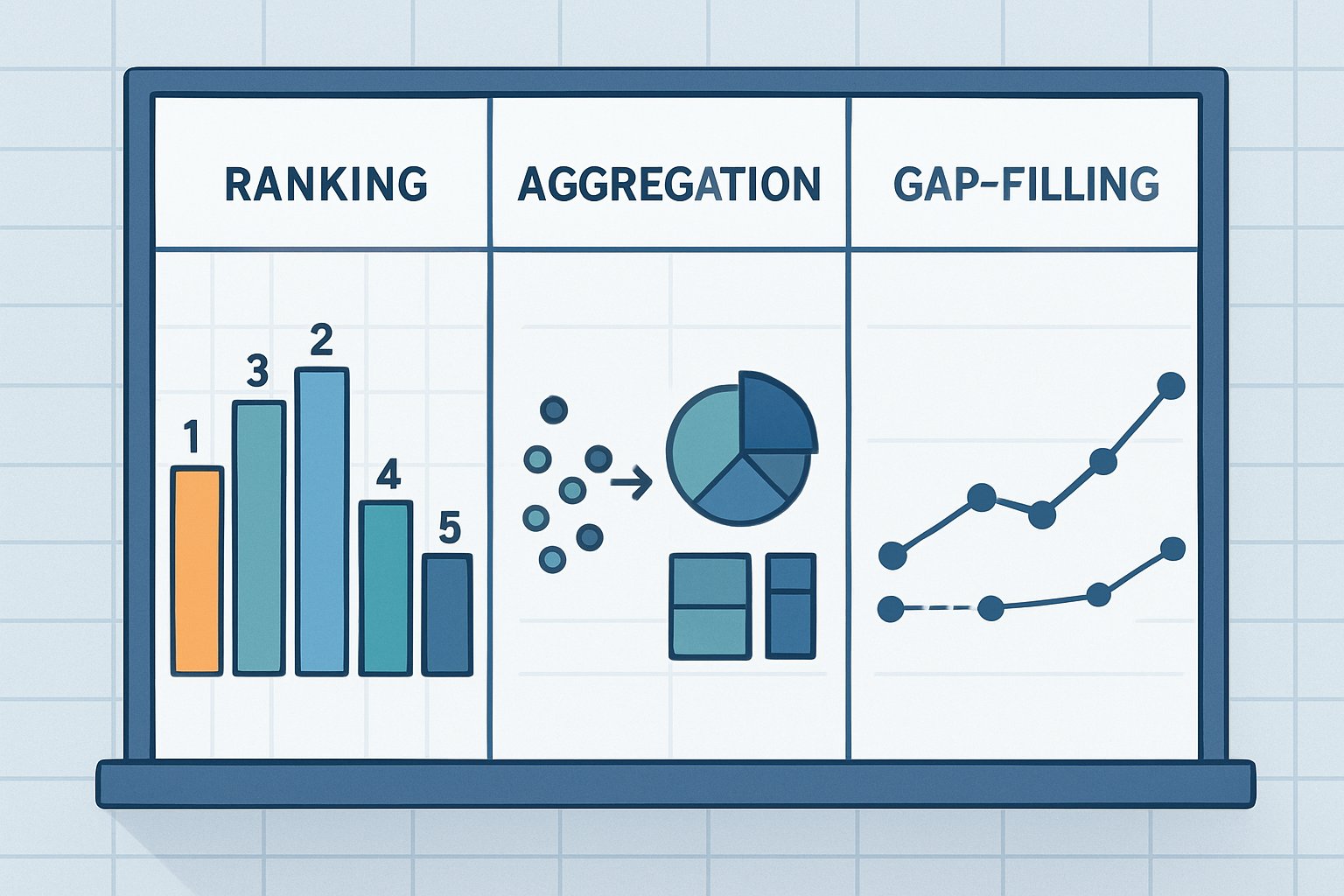SQL window functions empower data analysts to perform advanced calculations such as rankings, running totals, and gap-filling, all without reducing rows into groups as traditional aggregate functions do. These tools make it possible to calculate running totals, moving averages, rankings, and fill missing data gaps in a single query, reducing the need for complex subqueries or additional processing outside SQL.

Window functions work by partitioning data and performing calculations across related rows, all while maintaining each row’s individuality. The three main categories are ranking functions for identifying top performers, aggregation functions for cumulative calculations, and value functions for accessing data from other rows within the same partition.
Modern databases leverage window functions for time series analysis, financial reporting, and business intelligence. Mastering these functions is essential for anyone handling large datasets where traditional GROUP BY clauses can’t meet analytical needs.
Key Takeaways
- Window functions calculate across related rows while preserving each row, unlike GROUP BY operations that combine data
- The main types are ranking functions for ordering data, aggregation functions for cumulative totals, and value functions for accessing neighboring rows
- These functions are ideal for time series analysis, filling missing data, and complex business reporting
Fundamentals of Window Functions

Window functions perform calculations across a set of rows related to the current row, without reducing the result set. They use partitioning to divide data into groups and framing to specify which rows participate in each calculation.
What Is a Window Function?
A window function operates on a defined set of rows—called a window—while keeping the original number of rows in the result set. Unlike aggregate functions that group rows into single outputs, window functions return one value per row.
The OVER() clause defines the window for the function, specifying how to partition the data and which rows to include in the calculation.
Basic window function syntax:
window_function() OVER (
PARTITION BY column1
ORDER BY column2
ROWS BETWEEN start AND end
)The relational model benefits from window functions because they maintain row-level detail while providing aggregate insights. This allows users to view both individual records and calculated values in the same result set.
Partitioning and Framing Concepts
Partitioning splits the result set into separate groups using the PARTITION BY clause. Each partition is processed independently, similar to how GROUP BY creates groups.
Within each partition, framing defines the specific range of rows for calculations. The ORDER BY clause determines row sequence within partitions.
Two main framing options:
ROWS framing counts physical row positions:
ROWS BETWEEN 2 PRECEDING AND CURRENT ROWROWS BETWEEN UNBOUNDED PRECEDING AND UNBOUNDED FOLLOWING
RANGE framing considers logical value ranges:
RANGE BETWEEN INTERVAL '1' DAY PRECEDING AND CURRENT ROWRANGE BETWEEN 100 PRECEDING AND 100 FOLLOWING
Default framing behavior depends on the function. Ranking functions typically use the entire partition, while aggregate functions may use specific ranges.
Comparison with Aggregate Functions
Traditional aggregate functions reduce multiple rows to single values by grouping. Window functions preserve all original rows and add calculated columns.
| Feature | Aggregate Functions | Window Functions |
|---|---|---|
| Row count | Reduces rows | Preserves all rows |
| Grouping | Requires GROUP BY | Uses PARTITION BY |
| Detail level | Summary only | Individual + summary |
Aggregate window functions calculate values over defined windows while maintaining row-level detail. This enables users to view both granular and aggregate data in the same query.
A typical aggregate query might show total sales per month. The equivalent window function query displays every transaction along with running totals, monthly averages, or rankings.
This flexibility makes window functions valuable for analyses requiring both detail and summary information together.
Ranking with Window Functions

Ranking functions assign numeric positions to rows based on specific criteria within defined partitions. These functions handle duplicate values in different ways and offer methods for creating ordered lists and performance comparisons.
ROW_NUMBER, RANK, and DENSE_RANK
ROW_NUMBER, RANK, and DENSE_RANK are key ranking functions that each treat duplicate values differently. ROW_NUMBER assigns a unique sequential number to every row, even if values are identical.
RANK assigns the same number to tied values but creates gaps in the sequence. For example, if two employees are tied for second place, the next receives fourth place.
DENSE_RANK also assigns the same rank to ties but does not create gaps. Two employees tied for second place are both ranked 2, and the next is ranked 3.
Comparison of Ranking Functions:
| Function | Handles Ties | Creates Gaps | Sequential Numbers |
|---|---|---|---|
| ROW_NUMBER | No | No | Always |
| RANK | Yes | Yes | With gaps |
| DENSE_RANK | Yes | No | Without gaps |
SELECT name, score,
ROW_NUMBER() OVER (ORDER BY score DESC) as row_num,
RANK() OVER (ORDER BY score DESC) as rank_pos,
DENSE_RANK() OVER (ORDER BY score DESC) as dense_pos
FROM students;Using NTILE for Bucketing
NTILE divides ordered data into equal-sized groups or buckets, distributing rows as evenly as possible across the specified number of groups.
NTILE(4) creates quartiles, assigning about 25% of rows to each bucket. The function assigns bucket numbers from 1 up to the specified value.
SELECT customer_id, revenue,
NTILE(3) OVER (ORDER BY revenue DESC) as tier
FROM sales_data;If the total number of rows doesn’t divide evenly, NTILE places extra rows in the first buckets. For 10 rows and 3 buckets, the first gets 4 rows, the others get 3 each.
This method is useful for creating performance tiers, identifying top performers, or segmenting data for further analysis.
Handling Ties and Gaps
Ranking functions handle ties in unique ways, creating distinct numbering sequences. Knowing these differences helps select the right function.
RANK creates gaps equal to the number of tied rows minus one. For example, three employees tied for second place get ranks 2, 2, 2, followed by rank 5.
DENSE_RANK removes gaps, producing a continuous sequence. The same three tied employees get ranks 2, 2, 2, then 3.
Gap-filling strategies:
- Use DENSE_RANK for continuous sequences
- Apply ROW_NUMBER for unique identifiers
- Use RANK for traditional competition-style rankings
The PARTITION BY clause resets rankings within each group, ensuring consistent handling of ties across different categories.
Aggregation and Running Calculations

Window function aggregations retain individual rows while calculating values across related data. These functions enable incremental computations for running totals and moving averages without collapsing the dataset.
SUM, AVG, MIN, and MAX in Windows
Traditional aggregate functions reduce rows to single results. Window aggregates keep individual rows while calculating cumulative values over specified ranges.
SUM() computes running totals by adding values within the window, updating as each row is processed.
AVG() calculates moving averages across the window frame, useful for smoothing data trends and spotting patterns over time.
MIN() and MAX() identify extreme values within the current window, highlighting peaks and valleys as data is processed.
SELECT
order_date,
daily_sales,
SUM(daily_sales) OVER (ORDER BY order_date) AS running_total,
AVG(daily_sales) OVER (ORDER BY order_date ROWS 6 PRECEDING) AS weekly_avg
FROM sales_data;Data warehousing systems use these aggregations for real-time analytics, with calculations updating incrementally and efficiently.
Running Totals and Moving Averages
Running totals accumulate values from the partition’s start to the current row, showing cumulative growth or decline.
Moving averages smooth out fluctuations by averaging values over a fixed window. For example, a 7-day moving average includes the current day and the six previous days.
Frame specifications determine which rows are included:
| Frame Type | Description | Use Case |
|---|---|---|
| UNBOUNDED PRECEDING | From partition start | Running totals |
| N PRECEDING | Previous N rows | Moving averages |
| CURRENT ROW | Only current row | Point calculations |
Incremental computation models benefit from these patterns, as each new row requires minimal recalculation.
SELECT
customer_id,
purchase_amount,
SUM(purchase_amount) OVER (
PARTITION BY customer_id
ORDER BY purchase_date
) AS customer_lifetime_value
FROM transactions;These calculations support financial reporting and trend analysis, with aggregations performed at query time rather than through precomputed summary tables.
Gap-Filling and Time Series Analysis

Window functions are especially useful for handling incomplete time series data by filling missing values and detecting data gaps. The LAG and LEAD functions let analysts carry values forward or backward to replace missing points, and other techniques can identify and manage gaps in datasets.
Filling Missing Data with LAG and LEAD
LAG and LEAD offer effective ways to fill gaps in time series data by referencing previous or next values. LAG retrieves earlier values, while LEAD accesses subsequent ones.
Example gap-filling syntax:
SELECT
timestamp,
value,
COALESCE(value, LAG(value) OVER (ORDER BY timestamp)) AS filled_value
FROM sensor_data;LAG is ideal for forward-fill operations, filling missing values with the last known measurement. LEAD is used for backward-fill, replacing gaps with future values.
Advanced imputation techniques:
- Use
LAG(value, 1) IGNORE NULLSto skip multiple missing values - Combine LAG and LEAD for interpolation
- Apply range-based windows to limit how far to search
Managing buffers is important with large datasets. Setting appropriate window frames helps control memory usage and maintain data quality.
Locating and Handling Data Gaps
Data professionals need systematic approaches to identify and address gaps in time series datasets. Gap filling techniques help create continuous datasets required for analysis.
Common gap detection methods:
- Calculate time differences between consecutive records
- Generate expected timestamp ranges and compare against actual data
- Use ROW_NUMBER() to identify sequence breaks
Gap identification query:
SELECT
timestamp,
LAG(timestamp) OVER (ORDER BY timestamp) AS prev_timestamp,
DATEDIFF(minute, LAG(timestamp) OVER (ORDER BY timestamp), timestamp) AS gap_minutes
FROM measurements
WHERE DATEDIFF(minute, LAG(timestamp) OVER (ORDER BY timestamp), timestamp) > 5;Buffer management techniques help optimize performance when processing large time ranges. Analysts can partition data by date ranges or use sliding windows to process gaps incrementally.
Range-based gap handling:
- Define acceptable gap thresholds for different data types
- Create temporary tables with complete timestamp sequences
- Join original data with complete ranges to identify missing periods
Advanced Use Cases and Techniques
Window functions enable complex analytical tasks like comparing yearly performance metrics and identifying top performers within specific groups. Query optimization techniques help databases process these operations faster through adaptive methods and feedback systems.
Year-over-Year Comparisons
Year-over-year analysis requires comparing current values with previous year data. Window functions make this straightforward using LAG and LEAD functions with specific offset values.
The LAG function retrieves values from previous rows based on date ordering. Setting the offset to 12 months back provides the comparison baseline for growth calculations.
SELECT
month_year,
revenue,
LAG(revenue, 12) OVER (ORDER BY month_year) as prev_year_revenue,
((revenue - LAG(revenue, 12) OVER (ORDER BY month_year)) /
LAG(revenue, 12) OVER (ORDER BY month_year)) * 100 as yoy_growth
FROM monthly_salesPERCENT_RANK helps identify performance percentiles across time periods. This ranking function assigns percentage ranks within each partition of data.
Query optimization becomes critical with large datasets spanning multiple years. Databases use indexes on date columns to speed up window function processing.
Top N per Group Queries
Finding top performers within categories requires partitioned ranking functions. ROW_NUMBER assigns unique ranks while DENSE_RANK handles tied values appropriately.
The PARTITION BY clause groups data before applying ranking logic. This enables finding top sales reps per region or highest-selling products per category.
SELECT customer_name, region, total_sales
FROM (
SELECT customer_name, region, total_sales,
ROW_NUMBER() OVER (PARTITION BY region ORDER BY total_sales DESC) as rn
FROM customer_sales
) ranked
WHERE rn <= 5NTILE functions divide groups into equal buckets. This divides rows into equal-sized groups for quartile analysis or performance segmentation.
Modern databases optimize these queries through partition-wise processing. The engine processes each partition separately to reduce memory usage and improve speed.
Adaptive Optimization in Analytics
Database systems use adaptive optimization methods to improve window function performance over time. Query feedback mechanisms collect execution statistics to refine future query plans.
Incremental pointer-based access methods help databases process ordered data more efficiently. These methods maintain sorted pointers to avoid full table scans during window operations.
The optimizer learns from query patterns and adjusts strategies automatically. Frequently accessed partitions get cached in memory while less common data stays on disk.
Advanced SQL techniques for data engineering rely on these optimization features for large-scale analytics workloads. Systems monitor query execution times and resource usage patterns.
Query feedback helps identify performance bottlenecks in complex window operations. The database tracks which functions consume the most resources and suggests index improvements.
Adaptive methods adjust buffer sizes and memory allocation based on workload characteristics. This ensures consistent performance across different analytical scenarios and data volumes.
Best Practices for Performance and Efficiency
Window functions can consume significant memory and processing power when working with large datasets. Strategic indexing, precise frame definitions, and smart memory management help maximize query performance across different database architectures.
Indexing for Partition and Order Columns
Database engines process window functions most efficiently when indexes are not usually directly useful for window operations. However, clustered indexes that match PARTITION BY columns can reduce sorting overhead.
Primary Index Strategy:
- Create composite indexes on PARTITION BY columns first
- Add ORDER BY columns as secondary index components
- Match index sort order to window function requirements
Client-server database architectures benefit from indexes that minimize data transfer between storage and processing layers. The database server can use clustered indexes to group related partition data together physically.
Index Types by Use Case:
| Function Type | Recommended Index | Benefit |
|---|---|---|
| ROW_NUMBER() | Composite (partition + order) | Eliminates sorting |
| RANK() | Clustered on order columns | Reduces comparison overhead |
| SUM() OVER | Partition-focused index | Groups data efficiently |
Distributed databases require special attention to partition alignment. Indexes should match the distribution key to avoid cross-node data movement during window function execution.
Explicit Frame Definitions
Default frame definitions often scan more rows than necessary. Explicit ROWS or RANGE clauses limit the window scope and improve performance significantly.
Frame Specification Best Practices:
- Use ROWS instead of RANGE when possible
- Define UNBOUNDED PRECEDING only when needed
- Limit frame size with specific row counts
-- Efficient: Limited frame
SUM(sales) OVER (ORDER BY date ROWS 3 PRECEDING)
-- Inefficient: Default unbounded frame
SUM(sales) OVER (ORDER BY date)Buffer management techniques work better with smaller frames. The database can keep relevant data pages in memory longer when frame boundaries are clearly defined.
Performance Impact by Frame Type:
| Frame Definition | Memory Usage | Processing Speed |
|---|---|---|
| ROWS BETWEEN 1 AND 5 | Low | Fast |
| RANGE UNBOUNDED | High | Slow |
| CURRENT ROW | Minimal | Fastest |
Distributed databases process explicit frames more efficiently because each node can determine its required data subset without coordination overhead.
Memory Optimization Strategies
Window functions frequently demand additional memory for intermediate results, especially during sorting operations. Memory allocation strategies directly impact query execution time.
Memory Management Techniques:
- Process partitions in smaller batches
- Use temporary tables for complex multi-window queries
- Configure database buffer pools appropriately
- Monitor memory usage during execution
Client-server architectures benefit from server-side memory optimization. The server should allocate sufficient buffer space for window function intermediate results while maintaining memory for other concurrent operations.
Buffer Pool Configuration:
- Allocate 15-20% additional memory for window operations
- Set appropriate sort buffer sizes
- Configure work memory limits per connection
- Monitor memory pressure indicators
Distributed databases require coordination between nodes for memory management. Each processing node needs adequate local memory while maintaining network buffers for inter-node communication during window function execution.
Large datasets may require CTEs and window functions for improved efficiency compared to traditional subqueries. Breaking complex window operations into smaller steps reduces peak memory consumption.
Window Functions in Modern Database Architectures
Window functions have become essential components in contemporary database systems, with data warehouses leveraging them for complex analytics while both SQL and NoSQL platforms expand their analytical capabilities. These functions now operate seamlessly across distributed architectures and cloud-native environments.
Integrating Window Functions in Data Warehousing
Modern data warehouses rely heavily on window functions for real-time analytics and complex calculations. Window functions eliminate multi-step subqueries and self-joins, reducing query complexity significantly.
Cloud platforms like Snowflake, BigQuery, and Amazon Redshift optimize window function execution through columnar storage. These systems process partitioned data in parallel across multiple nodes.
Key warehouse implementations include:
- Materialized views with pre-computed window calculations
- Distributed processing for large partition sets
- Memory-optimized sorting for ORDER BY operations
- Automatic query plan optimization for window frames
Electronic database systems in warehouses use specialized indexing strategies. B-tree indexes on partition columns accelerate window function performance by 300-400% in typical scenarios.
Autonomous interoperable databases automatically tune window function queries. They adjust memory allocation and processing strategies based on data volume and complexity patterns.
Support Across SQL and NoSQL Platforms
Most modern relational engines support ANSI SQL window functions, including PostgreSQL, MySQL 8+, SQL Server, and Oracle. Each platform implements specific optimizations for window operations.
SQL Platform Capabilities:
| Database | Window Functions | Performance Features |
|---|---|---|
| PostgreSQL | Full ANSI support | Parallel processing |
| MySQL 8+ | Complete implementation | InnoDB optimizations |
| SQL Server | Advanced analytics | Columnstore indexes |
| Oracle | Extended functions | In-memory processing |
NoSQL systems increasingly adopt window-like functionality. MongoDB offers aggregation pipeline stages that mimic window operations. Apache Spark provides distributed window functions across cluster environments.
Heterogeneous DBMS environments require careful planning for window function compatibility. Cross-platform queries must account for syntax variations and performance characteristics between different database engines.
Object-oriented database systems integrate window functions through method-based approaches. These databases expose window operations as object methods rather than traditional SQL syntax.
Emerging Applications and Cross-Disciplinary Insights
Window functions are transforming computational analysis in scientific computing through Monte Carlo simulations and advancing genomic research with sophisticated sequence analysis techniques. These applications demonstrate how ranking and aggregation capabilities extend far beyond traditional database operations.
Simulations in Scientific Computing
Monte Carlo simulations rely heavily on window functions for analyzing random sampling results across multiple iterations. Scientists use ranking functions to identify statistical outliers and aggregation functions to calculate running averages of simulation outcomes.
Molecular dynamics simulations generate massive datasets tracking particle movements over time. Window functions help researchers analyze trajectory data by calculating moving averages of molecular positions and identifying transition states through gap-filling techniques.
The Monte Carlo method benefits from window functions when researchers need to partition simulation results by different parameters. NTILE functions divide results into quartiles for statistical analysis. LEAD and LAG functions compare consecutive simulation steps.
Drug delivery research uses molecular dynamics data with window functions to track how medications move through biological systems. Scientists apply aggregation functions to calculate average drug concentrations over specific time windows.
These simulations often require analysis of millions of data points. Window functions provide efficient ways to process temporal data without complex joins or subqueries.
Bioinformatics and Genomic Data Analysis
GMO detection methods increasingly rely on window functions to analyze genomic sequences and identify genetic modifications. Researchers use ranking functions to score potential modification sites based on sequence similarity patterns.
Nucleic acid-based detection techniques generate large datasets requiring sophisticated analysis. Window functions help identify sequence patterns by calculating rolling averages of base pair frequencies and detecting gaps in coverage data.
PCR primers analysis benefits from window functions when researchers need to evaluate primer efficiency across multiple experiments. Scientists use aggregation functions to calculate success rates and identify optimal primer combinations.
Certified reference materials analysis requires comparing experimental results against known standards. Window functions enable researchers to rank samples by similarity to reference molecules and identify statistical deviations.
The GMDD database and similar genomic repositories use window functions for quality control analysis. FIRST_VALUE and LAST_VALUE functions help identify sequence boundaries and validate data integrity.
GMO analysis methods often involve comparing multiple samples simultaneously. Window functions partition results by sample type while maintaining individual row identities for detailed comparison.
Frequently Asked Questions
Window functions solve specific data analysis challenges through ranking systems, cumulative calculations, and data gap identification. These functions provide alternatives to complex subqueries while maintaining row-level detail in results.
What are the practical uses of window functions in SQL?
Window functions are valuable for creating running totals in financial reports and sales dashboards. They can calculate moving averages for trend analysis and performance metrics.
Ranking functions are useful for identifying top performers in sales teams or highest-scoring students. They also help determine percentile rankings for salary comparisons across departments.
Gap-filling tasks include finding missing dates in time series data. Window functions can detect breaks in sequential order numbers or identify missing inventory items.
Year-over-year comparisons are simplified with LAG and LEAD functions, which access previous or next row values without the need for complex self-joins.
How do window functions differ from aggregate functions in SQL?
Aggregate functions collapse rows into single outputs, while window functions retain every original row. GROUP BY produces one result per group, but window functions add calculated columns to existing rows.
Aggregate functions like SUM() return one total value. Window functions with OVER() clauses return calculated values for each row while maintaining access to individual row details.
Window functions enable row-by-row calculations within groups, allowing users to view both individual values and group statistics in the same result set.
Can you explain how ranking works in SQL window functions?
ROW_NUMBER() assigns unique sequential numbers to rows within each partition, never producing duplicate rankings, even when values are identical.
RANK() gives identical rankings to tied values but skips subsequent numbers. If two rows tie for second place, the next row receives rank four, not three.
DENSE_RANK() assigns identical rankings to ties without skipping numbers. When two rows tie for second place, the next row receives rank three.
NTILE(n) divides result sets into equal-sized buckets, distributing rows evenly across specified number groups for quartile or percentile analysis.
How do window functions facilitate gap-filling in datasets?
LAG() and LEAD() functions help identify missing values by comparing current rows with adjacent ones, revealing gaps in sequential data like missing dates or order numbers.
Window functions can detect breaks in time series by checking date differences between consecutive rows, highlighting periods where no data exists in expected sequences.
FIRST_VALUE() and LAST_VALUE() can fill gaps by carrying forward or backward known values, propagating existing data to replace missing entries in datasets.
ROW_NUMBER() combined with expected sequences reveals missing items. Comparing generated sequences with actual data exposes gaps that require attention.
In which scenarios are window functions better than subqueries in SQL?
Window functions remove the need for complex self-joins for row-to-row comparisons and replace multiple subqueries with single, more readable statements.
Performance improves because window functions process data in single passes rather than multiple table scans. Database engines can optimize window operations more effectively than nested queries.
Running calculations like cumulative sums require simpler syntax with window functions, while subqueries would need increasingly complex WHERE clauses for each row’s calculation.
Window functions maintain better performance when calculating multiple related metrics, allowing single queries to replace multiple separate subquery executions.
What are some common mistakes to avoid when using window functions in MySQL?
Missing ORDER BY clauses in ranking functions can produce unpredictable results. Rankings may become inconsistent without explicit ordering specifications.
Forgetting the OVER() clause can convert window functions back to regular aggregates. This mistake may collapse result sets instead of preserving individual rows.
Using LAG() or LEAD() without default values can create NULL results for boundary rows. The first row in LAG() operations, for example, returns NULL unless defaults are specified.
Improper frame definitions might cause unexpected calculation ranges. ROWS BETWEEN clauses require careful specification to avoid including incorrect data ranges.




